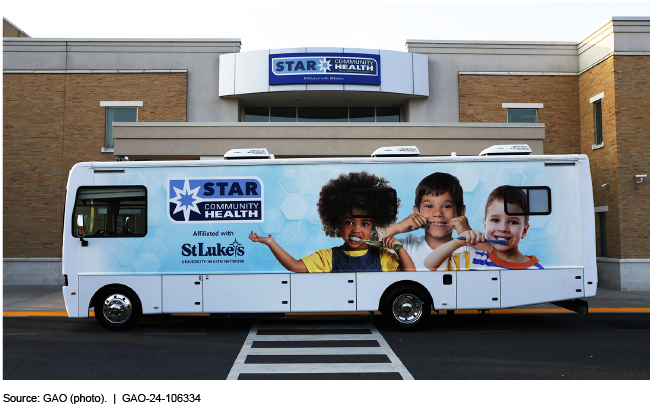Tracking the Funds: Sample of Fiscal Year 2022 Projects Shows Funds Were Awarded for Intended Purposes but Recipients Experienced Some Challenges
Fast Facts
As part of FY22 appropriations, Members of Congress could request to designate a certain amount of federal funding for specific projects in their communities. Congress approved $9.1 billion for 4,963 such projects. We track these funds to help ensure transparency.
We found that generally:
Recipients planned to use the funds for their intended purposes
Federal agencies planned to conduct oversight of projects before they are completed
Most of the recipients we spoke with said they faced challenges making their way through the steps needed to receive and use the funds.
One project plans to buy an additional mobile dental unit to provide services to a Pennsylvania school district.

Highlights
What GAO Found
The Consolidated Appropriations Act, 2022 designated a total of $9.1 billion for 4,963 projects at the request of Members of Congress. The act and its accompanying joint explanatory statement (JES) included specific provisions designating a certain amount of funds for particular recipients, such as a nonprofit organization or local government, to use for a specific project. These provisions are called Community Project Funding (CPF) in the House of Representatives and Congressionally Directed Spending (CDS) in the Senate. Projects for fiscal year (FY) 2022 are administered by 18 federal agencies.
Generally, FY 2022 CPF/CDS recipients planned to use the funds for their intended purposes specified in the act and its accompanying JES. The recipients' descriptions of projects' purposes were broadly consistent with the JES descriptions. Specifically, GAO found that all of the projects in its sample that moved forward with funding had a purpose that aligned with the project purpose described in the JES. Based on the sample, GAO estimates that 97 to 100 percent of all FY 2022 CPF/CDS projects had a purpose that aligned with the project purpose described in the JES.
At the time of GAO's review, agencies and recipients said that they would not move forward with the designated CPF/CDS funds for four projects in the sample for various reasons, such as the project receiving funding from an alternate source.
Many FY 2022 CPF/CDS recipients have begun spending the funds awarded to them. Specifically, about half of the recipients in GAO's sample who reported spending data began spending FY 2022 CPF/CDS funds by June 30, 2023, and 9 percent had spent all of their funds by this date.
Most recipients reported receiving technical assistance from federal agencies to help them navigate the funding process. However, most recipients also reported that they faced challenges completing the steps necessary to receive and implement the funds. For example, some recipients reported difficulty navigating agency application processes and lack of clear or timely agency communications. Agencies reported making improvements to address these challenges for projects funded in FY 2023. GAO will look at these types of issues as part of future oversight of CPF/CDS funds.
GAO found that agencies intended to conduct oversight for all but one project in its sample that moved forward with funding. For this one project, agency officials told GAO they did not plan to conduct oversight because the agency has an agreement with a state entity to conduct project oversight. Based on its sample, GAO estimates that agencies intend to conduct oversight for 95 to 100 percent of all FY 2022 CPF/CDS projects before they are completed. Further, GAO estimates that as of December 31, 2023, agencies had conducted oversight activities for 49 to 66 percent of all FY 2022 CPF/CDS projects for which they had reported obligating funds.
Officials from most agencies stated that they require interim reports that indicate how funds are being spent in accordance with recipients' spending plans, and officials from almost all agencies stated that they require final reports that indicate this information. As of December 31, 2023, agency officials reported receiving final reports for 11 of the projects in GAO's sample. Agencies will continue to collect interim and final reports throughout project progress. Final reports are generally due after project completion, according to officials from several agencies.
Why GAO Did This Study
The JES included a provision for GAO to review a sample of projects as part of Congress’s commitment to increased transparency for CPF/CDS funds. For this report, GAO examined the status of FY 2022 projects and how agencies are overseeing project implementation by reviewing a stratified random sample of 162 projects that can be generalized to the full population of projects. GAO’s Tracking the Funds website provides additional information on these projects as well as those funded in FY 2023, including obligation and outlay information. The website will be updated with information about FY 2024 projects and projects in subsequent fiscal years.
For more information, contact Jeff Arkin at 202-512-6806 or arkinj@gao.gov or Allison Bawden at 202-512-3841 or bawdena@gao.gov.
